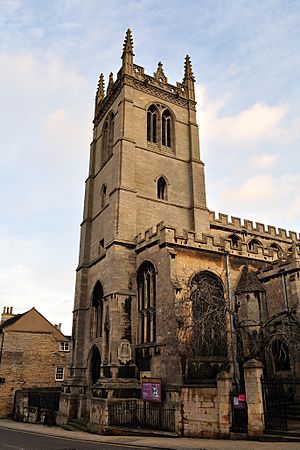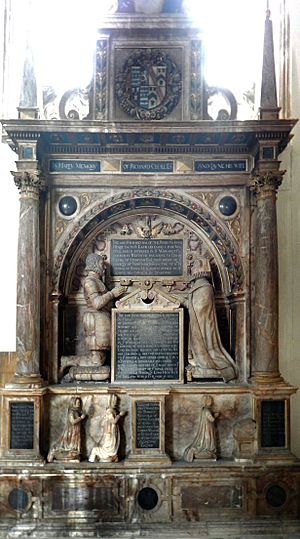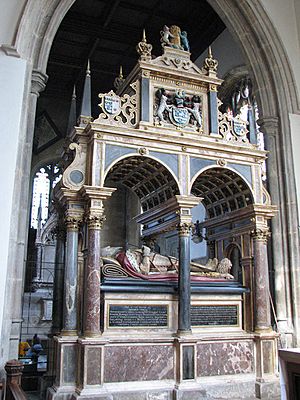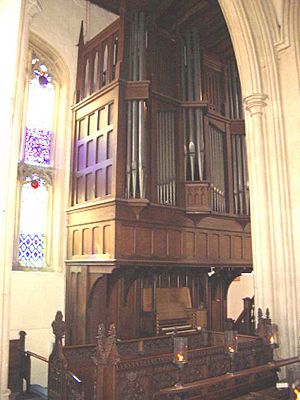St Martin's Church, Stamford facts for kids
Quick facts for kids St Martin's Church, Stamford |
|
|---|---|

St Martin's Church, Stamford
|
|
| Denomination | Church of England |
| Churchmanship | Broad Church |
| Website | www.stamfordchurches.co.uk/st-martins.shtml |
| History | |
| Dedication | Saint Martin |
| Administration | |
| Parish | St Martin's Without |
| Diocese | Lincoln |
| Province | Canterbury |
St Martin's Church, Stamford is a very old and important church in Stamford, Lincolnshire, England. It's known as a Grade I listed building, which means it's a special historic place. The church is part of the Church of England.
The area where the church stands, south of the River Welland, used to be in a different county, Northamptonshire, until 1889. This part of town is sometimes called Stamford Baron or St Martin's.
Contents
The Church's Story: A Look Back in Time


The very first church here was built a long time ago, between 1133 and 1147. It was built by Martin de Vecti, who was the Abbot of Peterborough. He named the church after his own saint, Saint Martin.
People believe the church might have been damaged during the Wars of the Roses in 1461. By 1473, it was in bad shape. So, they started rebuilding it in 1482 and finished in 1485. The new church was built in a style called the Perpendicular style, which is a type of late Gothic architecture with tall, narrow windows and detailed stone work.
In 1754, most of the old stained-glass windows were bought by the Earl of Exeter from another church.
The church got a big makeover in 1843 by Edward Browning. New pews (church benches) and a new pulpit (where the preacher stands) were added. The Cecil Chapel, a special part of the church, was made bigger in 1865. This chapel holds the tombs of the important Cecil family. These include monuments for Sir Richard Cecil, William Cecil, first Lord Burghley, and John Cecil, 5th Earl of Exeter.
During the 1800s, the church also received a new roof for the main area (nave), a lowered floor, and new bells. In 1890, a new organ was installed. New choir stalls (seats for the choir) and an altar were put in place in 1894, paid for by people in the parish.
Later, in the 1920s and 1930s, new decorative screens and a pulpit with carvings by Mahomet Thomas Phillips were added.
The church's full name is actually the Church of St Martin Without, Stamford Baron.
Some famous people are buried here. The Dutch portrait painter William Wissing (who passed away in 1687) is buried in the churchyard. Also, Daniel Lambert (who passed away in 1809), who was famous for his large size, is buried in a separate part of the churchyard.
Important Memorials
The church has many memorials to important people. Here are some of them:
- Sir Richard Cecil (who passed away in 1555)
- William Cecil, 1st Baron Burghley (who passed away in 1598)
- John Cecil, 5th Earl of Exeter (who passed away in 1700)
- Brownlow Cecil, 2nd Marquess of Exeter (who passed away in 1867)
- Benjamin Disraeli, 1st Earl of Beaconsfield (who passed away in 1881)
- William Cecil, 3rd Marquess of Exeter (who passed away in 1895)
- David Cecil, 6th Marquess of Exeter (who passed away in 1981)
The Church Bells
The church tower has a set of 6 bells that can be rung together. All of these bells were made in 1850 by Charles and George Mears. The largest bell, called the tenor, weighs about 1505 pounds (about 683 kilograms).
The Church Organ
Before 1890, the church organ was located in a balcony at the west end of the church. It had two keyboards and 14 different sounds (stops). The organ you see today was made by Bevington and was officially used for the first time on May 23, 1890. At the special service, Haydn Keeton, who was the organist at Peterborough Cathedral, played the organ. Later that day, Haydon Hare gave a concert.
Organ Players at St Martin's
Many talented people have played the organ at St Martin's Church over the years. Here are a few of them:
- John Speechley (who later became the organist at Peterborough Cathedral)
- Charles C Noble (who later became the organist at St Mary's Church, Nottingham)
- Richard Layton
- John Clare Billing
- Ernest John Charles Warner


